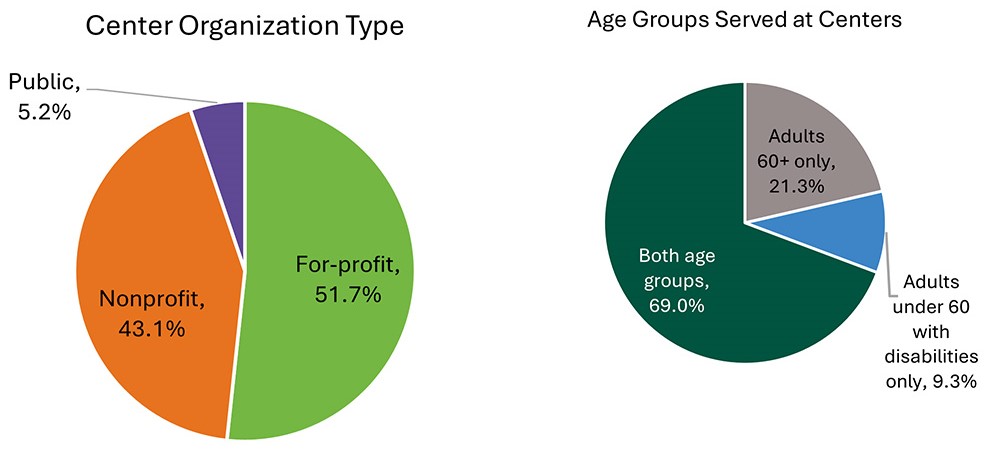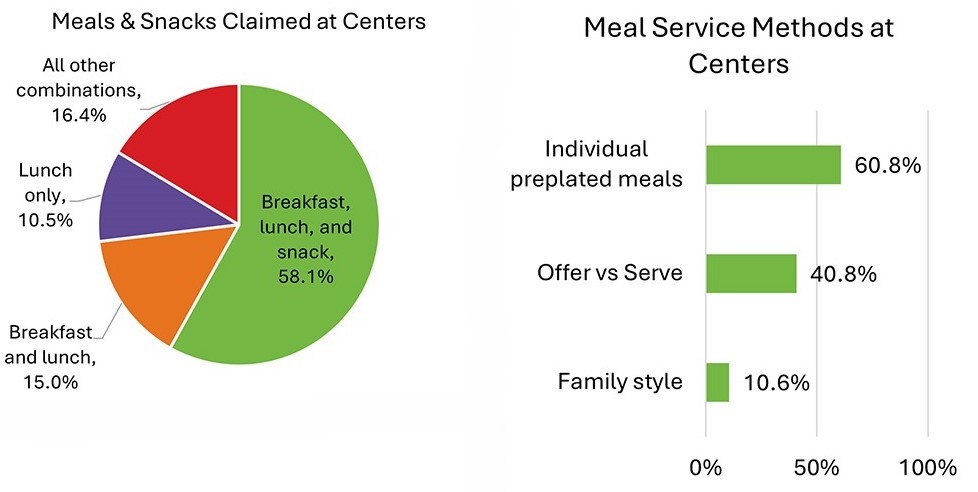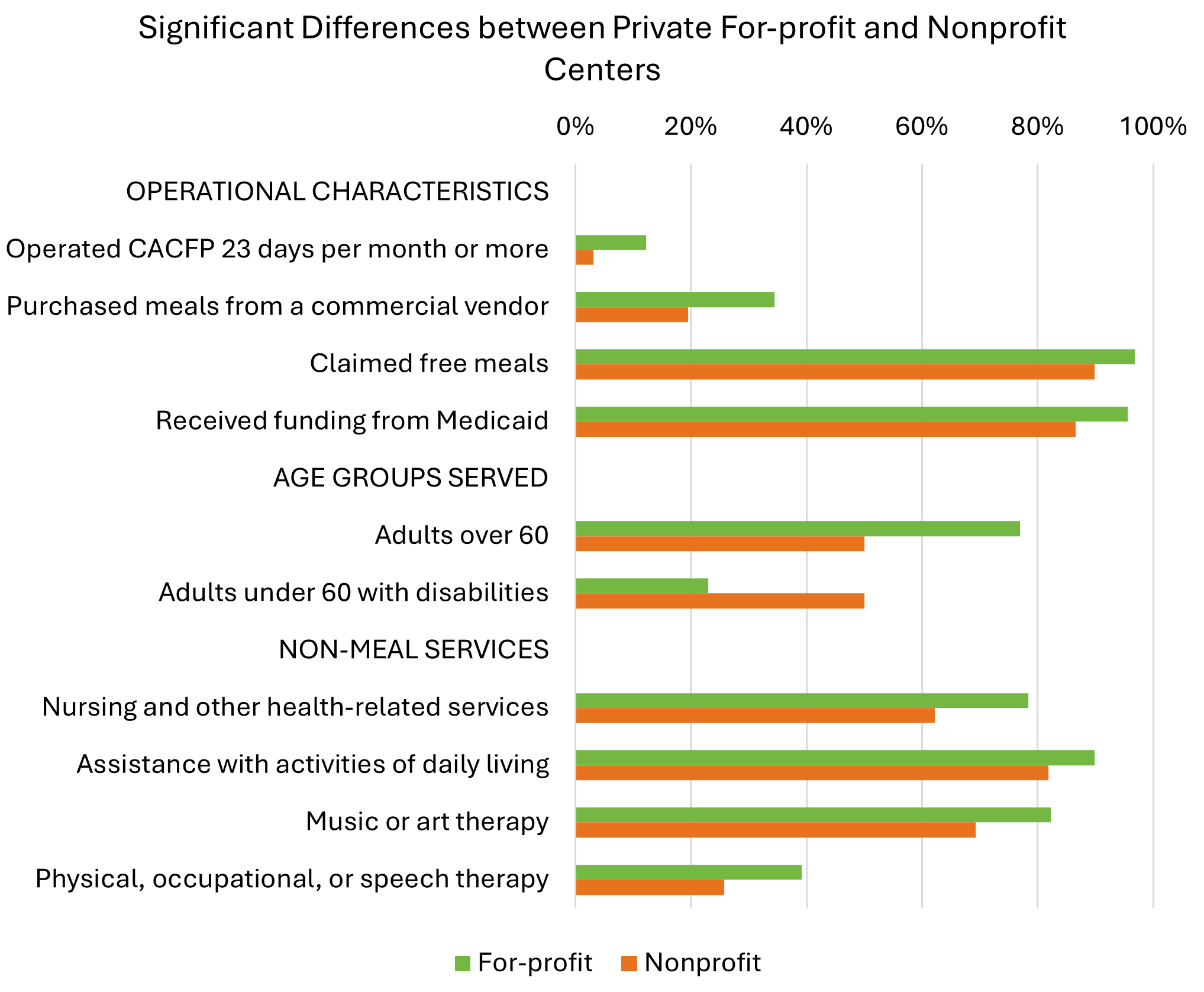Why did we do this study?
Adult day care centers have been eligible to operate the Child and Adult Care Food Program (CACFP) since 1987. Adult day care centers receive payments for serving nutritious meals to adults who are age 60 or older, or who are physically or mentally impaired to an extent that limits their independence and ability to carry out activities of daily living. Centers may receive payments for up to two meals and one snack per participant per day. See the CACFP Adult Day Care Handbook for more information about the program.
FNS collects administrative data, tracking aggregated sponsor, site, and attendance information on participating centers from states twice each fiscal year.
The objective of this study is to better understand key characteristics of adult day care centers participating in CACFP. Key characteristics include a) the types of organizations that participate in CACFP as adult day care centers and the populations they serve; and b) the meal services and non-meal services offered at CACFP adult day care centers.
How did we do this study?
Data was collected through a short survey sent to 2,495 adult day care centers located in 48 states (including the District of Columbia and Puerto Rico) that participated in CACFP in fiscal year (FY) 2023. The survey was conducted in early 2024 and 1,147 centers (47%) responded. Centers provided information about their meal services using October 2023 as a point of reference. Weights were used to correct for non-response.
FNS analyzed the frequency of responses to each question and conducted significance testing based on three center characteristics: organization type (private for-profit, private non-profit, or public), center size, and whether centers are independent or sponsored.
Findings
- The number of adult day care centers participating in CACFP varied widely from state to state and was not always proportional to the state’s population of older adults and people with disabilities. Over half of the 2,495 CACFP-participating adult day care centers in FY 23 were in just five states: Texas (14.1%), California (11.6%), Florida (9.1%), New Jersey (8.2%), and New York (7.3%).
- About half of centers (48.1%) operate CACFP independently, while fewer centers (43.3%) have a sponsoring organization that supports the administration of CACFP. The sponsor status of 8.6% of centers is unknown.
- CACFP Adult Day Care Centers and Participants
- Just over half (51.7%) of centers identified themselves as private, for-profit organizations (see Figure 1).
- Most centers (69%) serve both adults over age 60 and adults under age 60 with disabilities (see Figure 1).

Figure 1. Characteristics of Adult Day Care Centers Participating in CACFP in fiscal year 2023.1 - Two-thirds (67.1%) of the population served at centers in October 2023 were adults over age 60.
- Adults who participated in CACFP at adult day care centers were substantially more likely to be non-White than the general population of older adults and people with disabilities. Adults identifying as Asian were much more likely to participate in CACFP at adult day care centers compared to their share of the population.
- Meal Services Offered at Participating Centers in October 2023
- According to FNS administrative data, nearly all meals claimed by adult day care centers in October 2023 were free (96%). Survey results indicate that nearly all participants (92.5%) who ate a CACFP meal at adult day care centers in October 2023 were certified for free meals.
- Most centers (59%) only claimed free meals in October 2023. Another 16.7% claimed free and paid meals, while 16.1% claimed free, reduced-price, and paid meals.
- Most centers (58.1%) claimed breakfast, lunch, and snack services (See Figure 2).

Figure 2. Characteristics of Meal Services at Adult Day Care Centers Participating in CACFP in October 2023. 2 - Almost every center claimed lunch (96.9%) in October 2023, and very few centers (6.7%) claimed suppers.
- Most centers (55.6%) prepared CACFP meals on site, and just over one quarter (27.1%) purchased meals from a commercial vendor.
- Most centers (60.8%) served individual meals, either pre-plated or “boxed” (See Figure 2).
- The top five non-meal services centers provided were: exercise/physical activities (88.5%); assistance with activities of daily living (85.9%); music or art therapy (75.6%); nursing and other health-related services (70.5%); and mental, behavioral health, or social work services (56.0%).
- For-profit vs. Nonprofit Centers
- For-profit adult day care centers are only eligible to participate in CACFP if they receive compensation under Title XIX (Medicaid) and/or Title XX (Social Services Block Grant) of the Social Security Act and at least 25% of enrolled participants receive Title XIX or Title XX benefits. Just over half (54%) of for-profit centers reported that all CACFP participants were also Title XIX or Title XX recipients.
- Most for-profit centers (97%) are in just 14 states. In the four states with the most CACFP adult day care centers, most centers were for-profit: Texas (91% of all centers), California (79%), Florida (70%), and New Jersey (80%).
- For-profit centers accounted for about 72 % of all meals claimed in the adult daycare component of CACFP in October 2023, while private, nonprofit centers accounted for 24.9 %. The remaining 3.3 % of meals were claimed by public centers.
- Compared to non-profit centers, for-profit centers were significantly more likely to claim free meals and to serve a larger proportion of adults over age 60. Other significant differences between for-profit and nonprofit centers are shown in Figure 3.

Figure 3. Significant Differences between Private For-profit and Nonprofit Centers Participating in CACFP.3
1 Source: U.S. Department of Agriculture, Food and Nutrition Service, CACFP Adult Daycare 2023 Characteristics Survey, Spring 2024, Question #1 and Question #6.
2Source: U.S. Department of Agriculture, Food and Nutrition Service, CACFP Adult Daycare 2023 Characteristics Survey, Spring 2024, Questions #13 through #16 and Question #18. Centers could select multiple meal service methods in their response to Question #18. Offer versus Serve is described on page 35 of the CACFP Adult Day Care Handbook.
3 Source: U.S. Department of Agriculture, Food and Nutrition Service, CACFP Adult Daycare 2023 Characteristics Survey, Spring 2024. All differences are statistically significant at p≤ 0.05.

